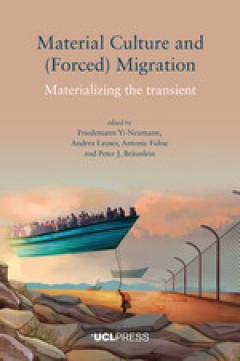Ditapis dengan

EXPLORING MATERIALITY AND CONNECTIVITY IN ANTHROPOLOGY AND BEYOND
Exploring Materiality and Connectivity in Anthropology and Beyond provides a new look at the old anthropological concern with materiality and connectivity. It understands materiality not as defined property of some-thing, nor does it take connectivity as merely a relation between discrete entities. Somewhat akin to Heisenberg’s uncertainty principle, it sees materiality and connectivity as tw…
- Edisi
- -
- ISBN/ISSN
- 9781787357488
- Deskripsi Fisik
- xvii, 259 p. ill;
- Judul Seri
- -
- No. Panggil
- 306 EXP P

MATERIAL CULTURE AND (FORCED) MIGRATION :MATERIALIZING THE TRANSIENT
Material Culture and (Forced) Migration argues that materiality is a fundamental dimension of migration. During journeys of migration, people take things with them, or they lose, find and engage things along the way. Movements themselves are framed by objects such as borders, passports, tents, camp infrastructures, boats and mobile phones. This volume brings together chapters that are based on …
- Edisi
- -
- ISBN/ISSN
- 9781800081604
- Deskripsi Fisik
- xvii, 372 p. ill;
- Judul Seri
- -
- No. Panggil
- 304.8 MAT F

REMAINS OF THE SOVIET PAST IN ESTONIA :AN ANTHROPOLOGY OF FORGETTING, REPAIR …
What happens to legacies that do not find any continuation? In Estonia, a new generation that does not remember the socialist era and is open to global influences has grown up. As a result, the impact of the Soviet memory in people’s conventional values is losing its effective power, opening new opportunities for repair and revaluation of the past. Francisco Martinez brings together a numb…
- Edisi
- -
- ISBN/ISSN
- 9781787353534
- Deskripsi Fisik
- xix, 255 p. ill;
- Judul Seri
- -
- No. Panggil
- 974.98 REM F

At home in Renaissance Bruges :connecting objects, people and domestic spaces…
How did citizens in Bruges create a home? What did an ordinary domestic interior look like in the sixteenth century? And more importantly: how does one study the domestic culture of bygone times by analysing documents such as probate inventories? These questions seem straightforward, yet few endeavours are more challenging than reconstructing a sixteenth-century domestic reality from written so…
- Edisi
- -
- ISBN/ISSN
- 9789462703179
- Deskripsi Fisik
- 320 p
- Judul Seri
- -
- No. Panggil
- 747.249332 DEG a
 Karya Umum
Karya Umum  Filsafat
Filsafat  Agama
Agama  Ilmu-ilmu Sosial
Ilmu-ilmu Sosial  Bahasa
Bahasa  Ilmu-ilmu Murni
Ilmu-ilmu Murni  Ilmu-ilmu Terapan
Ilmu-ilmu Terapan  Kesenian, Hiburan, dan Olahraga
Kesenian, Hiburan, dan Olahraga  Kesusastraan
Kesusastraan  Geografi dan Sejarah
Geografi dan Sejarah